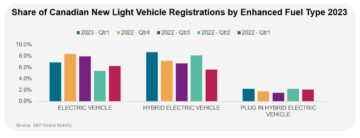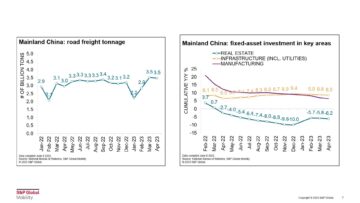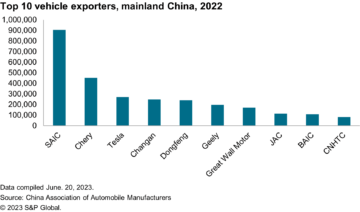
AccessMobility News & Assets Community for
mobilitynews clippings, thought-leadership articles,
on-demand podcasts, webcasts and other assets of essential
intelligence- contributed by our team of experts and
partners.]
Europe sales
January 2023: +3.6%; 1.160 million units vs. 1.120 million
units
- The latest European forecast has brought a glimmer of
positivity. However, the comparison with pre-pandemic volumes
highlights how far registrations have dropped. The growth rate
during the month is compared with January 2022, when the full
extent of the semiconductor supply issues started to emerge.
European light vehicle registrations improved compared with the
previous months and posted an increase of 3.6% year on year (y/y)
in the January forecast. The slow recovery in January was
exacerbated by the improved but ongoing semiconductor situation.
Also, the war in Ukraine continues to hold the market back. With
inventory having already been whittled back and a lack of
components causing many to halt production in 2022, vehicle
availability significantly dropped, causing far weaker
registrations. Although there has been some improvement in this
situation, major OEMs continue to struggle to source enough
components to address lengthy waiting lists. The main factor that
will be hitting its performance will again be the shortage of
semiconductors. Despite the impact of the semiconductor supply
situation in January, vehicle availability should improve somewhat
in 2023-24. Passenger car registrations in the European region will
likely increase 6.2% y/y during 2023 to about 15.8 million units.
However, this will be about 21% below the five-year pre-COVID-19
pandemic average.
- Sales in Europe fell 20.9% in January 2023 compared with the
same period in 2020, before the crisis. The increase in the region
last month was determined by opposing trends between the EU26+
European Free Trade Association (EFTA) and the Eastern European
market. The main factor that will affect its performance will again
be the shortage of semiconductors. This hit most OEMs’ production
from early 2021, but the semiconductor shortage still significantly
affects sales volumes throughout the region. Nevertheless, there
were strong gains in some markets. The strongest gains were seen in
markets, such as Belgium (up 20.8%), Austria (up 19.5%), Greece (up
89.8%), Italy (up 16.4%), Portugal (up 44.8%), Spain (up 49.1%) and
the United Kingdom (up 14.8%). Some markets posted wins in January,
such as France (up 8.2%), the Netherlands(up 7.7%), and Denmark (up
1.3%). In contrast, markets such as Finland (down 7.6%), Germany
(down 1.6%), Sweden (down 24.0%), and Norway (down 58.6%) posted
losses in January.
- Moreover, the implemented car stimulus programs still directly
affect the recovery of the different markets, although some of
these programs that started after the strict lockdowns in 2020 have
already stopped or the incentives were lowered. Looking back to
2022, the Western European market started weak into first quarter
2022. However, with the increasing shortages of semiconductors and
the start of the Russia-Ukraine conflict, the region’s performance
gradually weakened so that demand surpassed supply. This resulted
in long-waiting periods for ordered new vehicles, as well as
increased demand and prices on the used-car markets. Recovery
cycles will largely be determined by the normalization of
semiconductor supplies that started in the final quarter of 2022.
The risk of another winter of high COVID-19 infections and
restrictions luckily did not happen. The crisis intensifies
operational and economic pressures on an already-stressed global
automotive industry, especially as OEMs and suppliers finetune
strategies toward coping with “new normal” vehicle demand
levels.
- We remain cautious on recovery prospects, with key markets
likely to experience differing demand cycles. Light vehicle
registrations in the wider Western European region will increase
7.5% y/y in 2023 to about 12.5 million units.However, this would be
about 21.0% below the pre-COVID-19 pandemic average in
2015-19.
- We continue to forecast a winter recession. Various headwinds
are weighing on domestic and external demand, including high
inflation eroding household real incomes, weak sentiment, high
uncertainty, and tightening financial conditions. Leading
indicators, including our Purchasing Managers’ Index™ (PMI™) data,
started to pick up in late 2022 but remain at levels indicative of
a mild recession. Still, with energy-related risks having
diminished recently, we have revised up our real GDP growth
forecasts.
- Consumer price inflation will continue to fall in 2023. HICP
inflation markedly declined in November and December 2022,
under-shooting market consensus expectations in both months,
primarily driven by energy prices. Base effects will push down hard
on energy and food inflation rates over the coming months, and the
moderation in surveys of industrial firms’ pricing intentions and
declining producer price inflation rates are also indicative of
lower core goods inflation. Services inflation rates should also
ease as the boost from pent-up demand fades.
- Policy rates will rise further in early 2023. Having delivered
exceptional back-to-back 75-basis-point policy rate hikes at its
meetings in September and October 2022, the European Central Bank
(ECB) raised its deposit facility rate (DFR) by 50 basis points in
December 2022 to reach 2%, the highest level since 2008. The ECB’s
guidance remains indicative of additional rate hikes given concerns
about persistently high inflation and related risks, and we
forecast a peak for the DFR of 3% in March. This is supporting the
euro, which, along with other currencies, has markedly rebounded
against the US dollar.
- Longer-term eurozone growth prospects will remain challenging.
Looking beyond the short-term headwinds to growth, structural
factors will likely restrain eurozone real GDP growth rates.
Demographic trends are unfavorable in many member states, while
productivity growth has been on a long-term downward trend. Member
states with very elevated public-sector debt burdens will also need
large, multiyear fiscal adjustments. Market pressure for fiscal
tightening will likely build as the European Central Bank (ECB)
reduces its policy support. We estimate a long-term potential real
GDP growth rate for the eurozone of around 1%.
- Light vehicle registrations in the wider Western European
region will increase 7.5% y/y in 2023, compared with the low base
in 2022, falling below 11.7 million units. This will be about 21.8%
below the COVID-19 pre-pandemic average in 2015-19. However, the
market should also continue to grow over the coming years to peak
at about 14.0 million units in 2025. Compared with the development
in Western Europe, demand in Central Europe was a bit stronger and
recorded a solid gain compared with the same month in 2022, with
105,984 units, which means a 12.9% gain. For full-year 2022, the
market was down 5.7%. Increases and volume gains in January were
evident in many Central European markets, such as Bulgaria (up
9.5%), Hungary (up 14.5%), Poland (up 21.4%), and Romania (up
22.1%). The main negative drivers in January were Slovakia (down
0.7%) and Slovenia (down 1.5%). In addition, Eastern Europe showed
a much weaker result compared with the other two markets in the
European region. Demand in Eastern Europe during the month fell
again (down 34.0%) compared with the same period in 2022. The main
reason for this weak volume was the strong loss in the Ukrainian
market (down 38.8%), which is related to Russia’s invasion in
Ukraine. Moreover, the Russian market showed a loss (down 64.1%)
compared with the same month in 2022.
- As for full-year 2022, the European light vehicle market posted
a loss of 11.2%, with sales of 14,881,293 units, mainly because of
the limited supply due to the semiconductor shortages and the
Russia-Ukraine conflict. The results were affected by losses in
Western Europe (down 6.1%) and strong losses in Eastern Europe
(down 33.9%). The Central European region performed only slightly
better than the Western European market with a loss of 5.7% for
full-year 2022. The semiconductor shortages will affect the
short-term development, at least through the first half of
2023.
- Protectionism is a prominent source of concern. The threat of
an all-out trade war could be enough to defer some expenditure,
especially investment. Emerging-market turbulence is an additional
headwind to growth and a source of uncertainty. Political
developments in Russia and Turkey, the potential effect on
sovereign yields and spreads, and contagion to other member states
also merit attention.
- For the western part of the continent, a slight gain is
expected in 2023, with an increase of 7.5% to 12.5 million
units—about 850,000 units more than in 2022. The Central
European region is also expected to improve and to achieve a gain
in 2023. We expect a slight gain of 3.9% to about 1.36 million
units. The gains in Western and Central Europe combined will reach
13.88 million units in 2023—about 6.9% above the 2022 level,
but still more than 4.2 million units fewer than in 2019.
- The Russian-Ukrainian military conflict has caused a major
disruption in our short-, medium-, and long-term assumptions in the
March forecast round. The current estimates are based on a rather
pessimistic scenario, which includes a protracted military
stand-off; persisting sanctions against Russia on behalf of the US,
the EU, and their allies even after the presidential elections in
Russia in 2024; and a slow recovery in Ukraine from the damage
caused by the military actions. In 2022, we saw negative dynamics
in all Eastern European countries, with the major losses in those
involved in the conflict: Ukraine (down 62.1%), Russia (down
60.6%), and Belarus (down 63.3%), which has been sanctioned for
offering its territory for Russian troops. The total Eastern
European market plunged 33.9% y/y. For 2023, only a slight
improvement is expected, the market will likely grow 2.0% up to
1.92 million units.
- In the current S&P Global Mobility scenario, light vehicle
sales in Eastern Europe will surpass the volume of 2021 only in
2033. Even then, it will not reach 4 million units. Instead, this
should happen in 2028, within the forecast period. In the longer
term, Western Europe is not expected to return to the 2007 sales
peak level. Some markets may even enter a demotorization phase in
the early stages of the next decade. Surprisingly, the recovery
path is expected to be on the positive side. Pent-up demand is
larger and, above all, releasing far sooner and faster than
anticipated. This result was helped by a general environment that
has been supportive, which includes extremely low energy prices,
fast gains in purchasing power in many countries, and the ECB’s
monetary policy. However, for the longer term, many of the core
issues, including public debt, unemployment, and pension systems,
will still be in place. Moreover, Europe will have to cope with
structural constraints, such as dull demographics (with some
exceptions), increasingly constraining transport legislation, and
disruptive social evolutions (e.g., shifts in transport habits and
relationship with cars) in the same time frame, which could hamper
vehicle sales potential. The continent must also cope with the
Brexit effect. Moreover, the transfer to electrification will lead
to a phase of uncertainty because it is not clear which concept
(plug-in hybrid electric, battery electric, compressed natural gas,
fuel cell, gasoline, or diesel) will come out on top. In the
private-car buyer sector especially, the uncertainty will continue
because no one wants to remain with an “outdated” car or concept.
In addition, OEMs’ fleet CO2 emissions targets starting from
2020/21 will be a huge challenge for all participants and will
affect the market structure, powertrain mix, and car prices. On the
positive side, growth in Central European countries should become
more sustainable, as the market is far from saturated, and new
demand, i.e., newcomers to the new-car market, should keep
building, along with wealth and income gains. Eastern Europe should
also rebound in the medium-to-long term. Prospects in Turkey are
bright, thanks to strong demographic and economic potentials.
Russia presents a more complex case. Undoubtedly, this market can
easily yield 2.5 million units on a regular basis, but some
structural evolutions, e.g., creating a more diversified economy,
are necessary to turn the fragile giant into a top player.
Europe production
January 2023: +7.1%; 1.31 million units vs. 1.23 million
units
Western Europe, Central Europe, and Turkey
- With this February update, the data for 2022 production is
virtually fully actualized. As opposed to the rest of the world
where production fell in the fourth quarter over the third quarter,
this area saw a sequential improvement of 17% in the last quarter.
Looking at year-over-year development, fourth-quarter production
grew by 14% in Europe, excluding the Commonwealth of Independent
States (CIS), while it grew only marginally in the rest of the
world. As a result, production posted year-over-year growth of 22%
for the second half, and 5% on the full year.
- Compared with the reference year 2019, European production
decreased by 23% with Ford, Renault-Nissan-Mitsubishi, and
Jaguar-Land Rover all down by more than 30%; Volkswagen,
Stellantis, BMW, and Mercedes-Benz in the range of the regional
average; and Hyundai up by 9%.
- Looking at 2023, the general theme of supply chain disruption
transitioning to demand concerns remains intact. While fears of
production disruptions related to energy inputs have somewhat
abated, the flow of chips remains a constraint, and there is
increasing concern regarding the weight of demand on the level of
output for 2023. Although sequential improvement clearly continued
in fourth quarter 2022, the sales outlook becomes critical as
inventories are back to pre-semiconductor shortage levels (yet far
from pre-COVID levels).
- We are projecting the build pace will stabilize in the near
term. Given the weak base of comparison in the first half of the
year, it translates into 5% production growth across 2023. After
another year of recovery in 2024, volumes should stabilize in the
range of 16.5-17.0 million units, more than 3 million units below
the peak observed in 2017.
Russia and CIS
- Production is this area has collapsed since the end of February
when Russian armed forces invaded Ukraine. Production has been
interrupted at most plants in Russia, and the ones still running
are in restart mode with very soft volumes. Volumes in the second
half of the year are cut by nearly one-half, with Russia itself
being down by 70%. Although the outcome of the Russia-Ukraine
crisis is highly uncertain, the war will likely be followed by a
geopolitical impasse, and most official sanctions will likely be
indefinitely in place throughout the forecast. As a result, we
expect volumes to remain in the 1-million-unit range through the
horizon, while production reached 1.8 million units in 2021 and 2.4
million units in 2012-13.
This article was published by S&P Global Mobility and not by S&P Global Ratings, which is a separately managed division of S&P Global.
- SEO Powered Content & PR Distribution. Get Amplified Today.
- Platoblockchain. Web3 Metaverse Intelligence. Knowledge Amplified. Access Here.
- Source: http://www.spglobal.com/mobility/en/research-analysis/europe-sales-and-production-commentary-february-2023.html
- 000
- 1
- 11
- 2%
- 2017
- 2019
- 2020
- 2021
- 2022
- 2023
- 2024
- 7
- 9
- a
- abated
- About
- above
- Achieve
- across
- actions
- addition
- Additional
- address
- adjustments
- affect
- After
- against
- All
- already
- Although
- and
- Another
- Anticipated
- AREA
- armed
- around
- article
- articles
- Assets
- Association
- attention
- Austria
- automotive
- automotive industry
- availability
- average
- back
- Bank
- base
- based
- basis
- battery
- because
- become
- becomes
- before
- being
- Belarus
- Belgium
- below
- Better
- between
- Beyond
- Bit
- BMW
- boost
- Brexit
- Bright
- brought
- build
- Building
- Bulgaria
- car
- cars
- case
- caused
- causing
- cautious
- central
- Central Bank
- central europe
- chain
- challenge
- challenging
- Chips
- CIS
- clear
- clearly
- co2
- co2 emissions
- collapsed
- combined
- come
- coming
- commonwealth
- community
- compared
- comparison
- complex
- components
- concept
- Concern
- Concerns
- conditions
- conflict
- Consensus
- constraints
- Contagion
- continent
- continue
- continued
- continues
- contrast
- contributed
- Core
- could
- countries
- COVID-19
- Creating
- crisis
- critical
- currencies
- Current
- Cut
- cycles
- data
- Debt
- decade
- December
- Declining
- delivered
- Demand
- demographic
- Demographics
- Denmark
- deposit
- Despite
- determined
- Development
- developments
- DID
- diesel
- different
- differing
- directly
- Disruption
- disruptions
- disruptive
- diversified
- Division
- Dollar
- Domestic
- down
- downward
- driven
- drivers
- dropped
- during
- dynamics
- Early
- easily
- eastern
- eastern europe
- ECB
- Economic
- economy
- effect
- effects
- Elections
- Electric
- elevated
- Emissions
- energy
- energy prices
- enough
- Enter
- Environment
- especially
- essential
- estimate
- estimates
- Ether (ETH)
- EU
- Euro
- Europe
- European
- European Central Bank
- European Countries
- Eurozone
- Even
- evolutions
- exceptional
- excluding
- expect
- expectations
- expected
- experience
- experts
- external
- extremely
- Facility
- factors
- Fades
- Fall
- Falling
- far
- FAST
- faster
- fears
- February
- final
- financial
- Finland
- firms
- First
- Fiscal
- FLEET
- flow
- followed
- food
- Forces
- Ford
- Forecast
- Fourth
- FRAME
- France
- Free
- from
- Fuel
- full
- fully
- further
- Gain
- Gains
- GAS
- gasoline
- GDP
- gdp growth
- General
- geopolitical
- Germany
- giant
- given
- Global
- goods
- gradually
- Greece
- Grow
- Growth
- Half
- happen
- Hard
- having
- headwinds
- helped
- High
- High inflation
- highest
- highlights
- highly
- Hikes
- Hit
- hitting
- hold
- horizon
- household
- How
- However
- HTML
- HTTPS
- huge
- Hungary
- Hybrid
- Hyundai
- Impact
- implemented
- improve
- improved
- improvement
- in
- Incentives
- includes
- Including
- Income
- Increase
- increased
- Increases
- increasing
- increasingly
- independent
- Indicators
- industrial
- industry
- Infections
- inflation
- instead
- Intensifies
- intentions
- interrupted
- invasion
- inventory
- investment
- involved
- issues
- IT
- Italy
- itself
- January
- Keep
- Key
- Kingdom
- Lack
- large
- largely
- larger
- Last
- Late
- latest
- lead
- leading
- Legislation
- Level
- levels
- light
- likely
- Limited
- Lists
- lockdowns
- long-term
- longer
- looking
- loss
- losses
- Low
- Main
- major
- managed
- Managers
- many
- March
- Market
- Market Structure
- Markets
- means
- meetings
- member
- Merit
- Military
- million
- mobility
- Mode
- moderation
- Monetary
- Monetary Policy
- Month
- months
- more
- most
- multiyear
- Natural
- Natural Gas
- Near
- nearly
- necessary
- Need
- negative
- Nevertheless
- New
- newcomers
- news
- next
- normal
- Norway
- November
- october
- offering
- official
- ONE
- ongoing
- operational
- opposed
- Other
- Outcome
- Outlook
- Pace
- pandemic
- part
- participants
- partners
- path
- Peak
- pension
- performance
- period
- periods
- persistently
- pessimistic
- phase
- pick
- Place
- plants
- plato
- Plato Data Intelligence
- PlatoData
- player
- plunged
- Podcasts
- points
- Poland
- policy
- political
- Portugal
- positive
- Positivity
- posted
- potential
- power
- presents
- presidential
- pressure
- previous
- price
- Prices
- pricing
- primarily
- producer
- Production
- productivity
- Programs
- prominent
- prospects
- public
- public-sector
- published
- purchasing
- Push
- Quarter
- raised
- range
- Rate
- rate hikes
- Rates
- rather
- ratings
- reach
- reached
- real
- reason
- rebound
- recently
- recession
- recorded
- recovery
- reduces
- regarding
- region
- regional
- regular
- related
- relationship
- remain
- remains
- REST
- restrictions
- result
- Results
- return
- Rise
- Risk
- risks
- Romania
- round
- rover
- running
- Russia
- russian
- S&P
- S&P Global
- sales
- same
- Sanctioned
- Sanctions
- scenario
- Second
- sector
- semiconductor
- Semiconductors
- sentiment
- separately
- September
- Services
- Shifts
- short-term
- shortage
- shortages
- should
- significantly
- since
- situation
- Slovenia
- slow
- So
- Social
- Soft
- solid
- some
- somewhat
- Source
- sovereign
- Spain
- Spreads
- stabilize
- stages
- start
- started
- Starting
- States
- Still
- stimulus
- stopped
- strategies
- strict
- strong
- stronger
- structural
- structure
- Struggle
- such
- suppliers
- supply
- supply chain
- support
- Supporting
- supportive
- surpass
- surpassed
- sustainable
- Sweden
- Systems
- targets
- team
- The
- the United Kingdom
- the world
- their
- theme
- Third
- threat
- Through
- throughout
- tightening
- time
- to
- top
- Total
- toward
- trade
- transfer
- transitioning
- transport
- Trend
- Trends
- turbulence
- Turkey
- TURN
- Ukraine
- Ukrainian
- Uncertain
- Uncertainty
- undoubtedly
- unemployment
- United
- United Kingdom
- units
- Update
- us
- US Dollar
- various
- vehicle
- Vehicles
- virtually
- volkswagen
- volume
- volumes
- Waiting
- war
- War in Ukraine
- Wealth
- weighing
- weight
- Western
- Western Europe
- which
- while
- wider
- will
- Wins
- Winter
- within
- world
- would
- year
- years
- Yield
- yields
- zephyrnet
More from IHS Markit
Automotive Insights – Canadian EV Information and Analysis Q1 2023
Source Node: 2109489
Time Stamp: May 19, 2023
EVs won’t be enough for automakers to hit Paris climate targets. What can OEMs do?
Source Node: 2402965
Time Stamp: Nov 28, 2023
Growing inventories and falling prices, but US auto sales growth still progressing slowly
Source Node: 2107081
Time Stamp: May 24, 2023
Will India’s MHCV production surpass its 2018 peak by 2025?
Source Node: 2331864
Time Stamp: Oct 16, 2023
Mainland China commercial truck production starts 2023 with a powerful rebound
Source Node: 2179816
Time Stamp: Jul 19, 2023
October inventory trends: strike vehicles, small SUVs, and electric vehicles
Source Node: 2347705
Time Stamp: Oct 25, 2023
Countdown to 2023: Sustained Passenger Vehicle Sales in October.
Source Node: 1783522
Time Stamp: Nov 4, 2022
China exported more than 3 million vehicles in ‘22 … and is soaring even higher this year
Source Node: 2152219
Time Stamp: Jun 28, 2023
The semiconductor shortage is – mostly – over for the auto industry
Source Node: 2168866
Time Stamp: Jul 11, 2023












